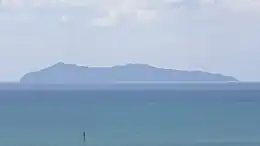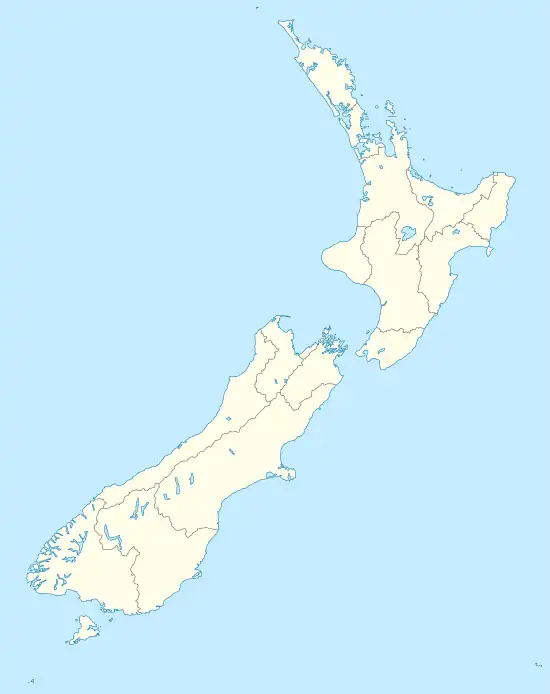Native name: | |
|---|---|
 Mayor Island / Tūhua as seen from Mount Maunganui | |
 Mayor Island / Tūhua  Mayor Island / Tūhua | |
| Geography | |
| Location | Bay of Plenty, North Island, New Zealand |
| Coordinates | 37°17′S 176°15′E / 37.283°S 176.250°E |
| Area | 13 km2 (5.0 sq mi) |
| Highest elevation | 355 m (1165 ft) |
| Administration | |
New Zealand | |
| Demographics | |
| Population | 4 |
Mayor Island / Tūhua is a dormant shield volcano located off the Bay of Plenty coast of New Zealand's North Island. It lies 35 kilometres (22 mi) north of Tauranga and covers 13 km2 (5 sq mi).
Geography
The island is quite steep along its coast and rises to 355 metres (1,165 ft) above sea level. A saddle about 75 metres (246 ft) deep separates it from the North Island, while the other side of the volcano rises from the seafloor some 400–500 metres (1,312–1,640 ft) beneath the waves.[1] Approximately 18,000 years ago during the Last Glacial Maximum when sea levels were over 100 metres lower than present day levels, Mayor Island / Tūhua was connected to the rest of New Zealand. Sea levels began to rise 7,000 years ago, separating Mayor Island / Tūhua from the mainland.[2] Hot springs may be found on the island's northern side, and there are two small crater lakes, Green Lake and Black Lake. These lie within two overlapping calderas formed in explosive eruptions 36,000 and 6,340 years ago.
Geology
Mayor Island is characterised as a peralkaline volcano and has exhibited a wide range of eruptive styles, including lava fountains, Strombolian explosions, extrusion of lava domes, phreatomagmatic explosions, Plinian falls and ignimbrite. The most recent lava flows have been dated at between 500 and 1,000 years old.[3][4]
The Tūhua Caldera formed in the >1 km3 (0.24 cu mi) eruptive volume event of 6,340 years ago and also is a partial collapse crater.[5] It is 2.2 km (1.4 mi) by 2.5 km (1.6 mi) in size.[6] The Tuhua Tephra is quite distinctive and due to it having two dispersion patterns has been found in the Auckland area where it is up to 7cm thick, at Rotorua up to 10cm thick and Lake Waikaremoana where it is 4cm thick, making it useful as a mid-Holocene marker horizon.[6] It has also been characterised from multiple sea bed cores off the East coast from the Havre trough off the Bay of Plenty to the southern North Island off Cape Turnagain.[6]
Te Paritu Tephra is assigned to a Mayor Island eruption [6] but the full recent significant eruptive sequence required sea cores as prevailing winds are off land.[7] In summary recent eruptions are:[8]
| Tephra Name(s) | Date before present (ka) |
|---|---|
| M1 | >50[7] |
| M2 | <50[7] |
| M3 | 40.5 |
| M4 (Mayor Island) | 37.4 |
| M5 | 22.2 |
| M6 (Te Paritu) | 14.2 |
| M7 (Tuhua) | 7 |
Risks
The island would likely be sterilised in a typical major pyroclastic eruption at their current frequency of about every 7,000 years although a small eruption could be confined within the caldera. Tsunami activity and ash affecting the Bay of Plenty are possible with initial vent clearing and ash falls toward the major cities of the northern half of the North island being most likely in summer, with economic disruption to especially ports and airports.[9] Usually however the ash fall will be away from land. However it has been estimated that a worse case tsunami could be 35 m (115 ft) high when it reached Bay of Plenty coastal resorts and the city of Tauranga with possibly only 30 minutes warning. Most of the infrastructure of these coastal towns is less than 15 m (49 ft) above sea level so is at risk of complete destruction.
History
Captain James Cook called it Mayor Island when he sighted it on 3 November 1769, in recognition of the Lord Mayor's Day to be held in London a few days later.
The Ngāti Whakaue led a military expedition to the island in 1842, after a tribesman was killed by the Whanau a Tauwhao, a hapu of Ngāi Te Rangi[10]
The island is considered special by Māori (the indigenous people of New Zealand) partly because of the presence of black obsidian, a volcanic glass created by the rapid cooling of silica-rich lava, prized as a cutting tool. The obsidian was called Tūhua by Māori, who called the island by the same name. Over 80% of obsidian excavated from Matakawau on Great Mercury Island had been sourced from Tūhua.[11] Several pa sites are known on the island, the final of which was inhabited until 1901.
Uses and recreation
The area of the Bay of Plenty around the island is renowned for game fishing, with marlin, mako sharks, and swordfish all inhabiting the surrounding waters. Some of the island and the waters close to its shores, however, are now a small marine reserve.[12] There are several tramping tracks around the island, and it is also popular with divers. Mayor Island today is a wildlife refuge.[13] A small number of holiday houses are located in Opo Bay on the south coast of the island, along with a camp ground and a few rental cabins.[14] The 2001 census showed a population of three, after zero in 1996 and 12 in 1991 (all figures randomised for privacy on a Base-3 system).[15]
See also
References
- ↑ New Zealand Hydrographic Chart Number 541: Mayor Island to Town Point (Okurei Point), Land Information New Zealand. Retrieved 29 April 2009.
- ↑ "Estuary origins". National Institute of Water and Atmospheric Research. Retrieved 3 November 2021.
- ↑ Houghton, B.F.; Wilson, J. N. C; Weaver, S.D.; Lanphere, M.A.; Barclay, J (1995). "Mayor Island Geology". Volcanic Hazards at Mayor Island. [Palmerston North, NZ]: Ministry of Civil Defence. Volcanic Hazards Information Series 6.: 1–23.
- ↑ Houghton, Bruce F.; Weaver, S.D.; Wilson, J. N.; Lanphere, M.A. (1992). "Evolution of a quaternary peralkaline volcano: Mayor Island, New Zealand". Journal of Volcanology and Geothermal Research. 51 (3): 217–236. Bibcode:1992JVGR...51..217H. doi:10.1016/0377-0273(92)90124-V.
- ↑ Lowe, D. J.; Balks }first2= M. R. (2019). "Introduction to Tephra-Derived Soils and Farming, Waikato-Bay of Plenty, North Island, New Zealand" (PDF).
{{cite web}}: CS1 maint: numeric names: authors list (link) - 1 2 3 4 Manighetti, B.; Palmer, A.; Eden, D.; Elliot, M. (2003). "An occurrence of Tuhua Tephra in deep‐sea sediments from offshore eastern North Island, New Zealand". New Zealand Journal of Geology and Geophysics. 46 (4): 581–590. doi:10.1080/00288306.2003.9515031. S2CID 131253941.
- 1 2 3 Shane, Phil; Sikes, E.L.; Guilderson, T.P. (2006). "Tephra beds in deep-sea cores off northern New Zealand: implications for the history of Taupo Volcanic Zone, Mayor Island and White Island volcanoes". Journal of Volcanology and Geothermal Research. 154 (3–4): 276–290. doi:10.1016/j.jvolgeores.2006.03.021. ISSN 0377-0273.
- ↑ Loame, Remedy Charlotte (2016). Using a tephrostratigraphic framework to determine the past 40,000 yrs of fault rupture and paleohydrothermal activity on the east strand of the Whirinaki Fault, Ngakuru Graben, central Taupo Volcanic Zone (PDF) (Thesis).
- ↑ Buck, M.D. (1985). "An assessment of volcanic risk on and from Mayor Island, New Zealand". New Zealand Journal of Geology and Geophysics. 28 (2): 283–298. doi:10.1080/00288306.1985.10422227.
- ↑ Paterson, Lachy; Wanhalla, Angela (21 August 2017). He Reo Wahine: Maori Women's Voices from the Nineteenth Century. Auckland University Press. ISBN 978-1-77558-927-3.
- ↑ Furey, Louise; Emmitt, Joshua; Wallace, Rod (2017). "Matakawau Stingray Point Pa excavation, Ahuahu Great Mercury Island 1955-56". Records of the Auckland Museum. 52: 39–57. doi:10.32912/ram.2018.52.3.
- ↑ "Tūhua (Mayor Island) Marine Reserve". Retrieved 27 August 2022.
- ↑ "Tuhua (Mayor Island)". Retrieved 27 August 2022.
- ↑ Places
- ↑ Census Archived 15 February 2016 at the Wayback Machine
External links
 Diving Mayor Island travel guide from Wikivoyage
Diving Mayor Island travel guide from Wikivoyage- Mayor Island Geology, by B.F. Houghton, C.J.N. Wilson, S.D. Weaver, M.A. Lanphere, and J. Barclay.
- Global Volcanism Program: Mayor Island
- There is a comprehensive article on Mayor Island in the New Zealand Geographic Magazine, number 3, July–September 1989.